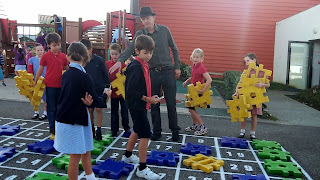 |
| See more on the Year 4 blog |
Our trees made a really big Forest of Factors display for the primary corridor. As the Year 2 and Year 3 children are passing it regularly, it was a good idea to explain the display to them. We did it without using the words "factor", "multiple" or "prime" so that it would be easier for them to understand:
"Hello everyone. This is our Forest of Factors."
"1, 2, 3, 4.... 40"
"What do you notice about our pictures?"
"Number 1 is my bird. It's different to all the other numbers. If you times something by 1 it just stays the same number."
"So 1 is special, and we don't think about it with our trees and mushrooms. It's just flying up in the sky!"
"Some of the numbers are simple trees. Look at 38. 38 is 19 times 2, so we've given it two branches that finish with flowers."
"Ten is five times two."
"26 is 13 times 2."
"These ones had just two branches and two flowers."
"But some of the trees have more flowers. Like 12, and 32."
"With the mushrooms there's no two numbers that you can times together to make that number."
"Can you see a number that is a mushroom?"
"So that's our Forest of Factors. We hope you understand it a bit better now."

















